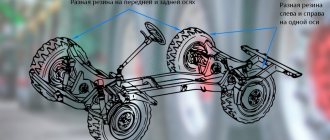Content:
- Differences between winter tires and summer tires
- What can be the consequences of using winter tires in summer?
- Traffic regulations
- Fines for driving a car on winter tires in summer
- When is the right time to change your winter tires to summer tires?
- Conclusion
With the establishment of warm weather in the regions, many drivers are faced with a number of difficult questions: is the air warm enough to change winter tires to summer ones, will there still be evening and morning frosts, have the queues at tire shops subsided? Such a keen interest in changing climatic conditions is very understandable: with the onset of a thaw, it is important to promptly change your car to tires for the season. The comfort and safety of driving depends on this. However, there are also those drivers who believe that friction Velcro and tires for mild European winters are quite suitable for use on summer roads. Is this so, and how dangerous is untimely replacement of tires, and what are the consequences of using tires out of season? You will find answers to these and other questions in this article.
Differences between winter tires and summer tires
Before answering the question of whether it is possible to drive on winter tires in the summer, it is worth taking a closer look at the characteristic differences between seasonal tires and the features of their operation. The difference between tires for a particular season lies in the tread pattern, compound composition and production technology. Summer tires and those used for winter always differ in the degree of hardness and level of adhesion to different types of road surfaces. This is due to the peculiarities of their operation. For example, summer tires for a car must withstand high temperatures and cope with braking on dry asphalt. The main elements of winter tires are considered to be dirt, snow and ice, where they should exhibit better grip and at the same time not become stiff in the cold. All-season tires stand out, which are suitable for use in regions with mild winters and not very hot summers. These tires act as a kind of intermediate option between summer and winter tires, but like any universal solution, they have a number of serious drawbacks. All-season tires don't handle hot temperatures as well as summer tires and don't brake as effectively on snow and ice as those designed specifically for winter.
Special markings will help you understand that you have winter tires. These tires are labeled "M+S" (or "M&S"), which indicates that they can be used for driving in snow and mud. The same markings are also on all-season tires, but they do not have one more element - a pictogram in the form of a snowflake against the backdrop of the Three Mountains. The latter indicates that the tires are suitable for use in cold, harsh winter conditions.
Differences between summer and winter tire compounds
In the production of seasonal tires, different rubber compounds are used. The composition of summer tires includes those particles that allow them to maintain characteristics when operating in positive temperatures up to +50-55 degrees. Winter tires have a different compound. It is designed for use in a separate climate zone with air temperatures in the range of +5-0 degrees and up to -45 degrees.
Differences between the tread patterns of summer and winter tires
In summer, cars travel mainly on good asphalt roads, which means they reach higher speeds. In this case, the tires must satisfy not only safety requirements, but also provide a comfortable ride, minimal fuel consumption, and good maneuverability. Winter tires face a slightly different task. These tires must cope with the rapid removal of water, slush from snow and mud, and brake well on slippery surfaces. For this reason, winter tires have a fairly deep tread with larger blocks and a more impressive number of sipes, which are often multidirectional. Additionally, metal spikes can be installed on such tires. They provide better grip on ice and packed snow. In summer, spikes are not only unnecessary, but also pose a danger to the driver. The use of studded tires also negatively affects the quality of the asphalt surface. For this reason, the tread of summer tires cannot be with spikes, and the blocks themselves are smaller in size, and the number of lamellas is significantly reduced.
What can the use of winter tires in summer lead to?
From year to year, there are those drivers who neglect logic and common sense and, in an attempt to save money, continue to drive winter tires in the summer. This often causes very disastrous consequences: from high levels of wear of expensive tires to the car getting into accidents of various sizes. So, let’s figure out why you can’t drive on winter tires with or without studs (Velcro) in the summer. Features of the compound and tire tread structure cause deterioration in the performance characteristics of winter tires when high temperatures occur. This causes the following negative consequences.
- Higher fuel consumption and tire noise.
- Less resistance to hydroplaning.
- Long braking distance on dry roads.
- Rapid tire wear.
- Excessive heat generation.
It is worth noting that winter tires are heavier than tires used in summer. This affects directional stability in different conditions and leads to increased fuel consumption. In addition to the practical side of the issue, do not forget about safety standards. Driving on winter tires in summer is dangerous, since the car handles worse on dry roads, may not be able to quickly remove the watery film from the tire contact patch and will have an increased braking distance.
Is it worth driving with winter tires in summer?
Using winter tires for purposes other than their intended purpose leads to a number of detrimental consequences for the car and the driver: a high risk of accidents on the roads, difficulties with driving, rapid wear and failure of a number of vehicle systems, increased fuel consumption and, finally, a fine.
The question of why it is necessary to change winter tires to a summer set has a clear answer - such trips on asphalt in the hot season will not bring anything good.
However, much depends on where the car is used and in what climatic conditions. On roads in northern latitudes, in the permafrost zone, it is worth adhering to common sense and the rules established for a specific region. The question of when to change tires to summer ones is resolved in a similar way. There is a widespread opinion about the timing of replacing a seasonal tire: March 15 – switch to summer tires, November 15 – switch to winter tires. However, there is no precisely established single date in the law, and tires must be changed, taking into account the climate of a particular region and specific weather conditions.
Traffic regulations
Lawmakers have repeatedly tried to introduce official restrictions against driving on winter tires in the summer. Relevant projects were submitted for discussion in 2009 and 2014. The first provided for a fine of 500 rubles for driving using studded winter tires on cars in the summer, the second implied a penalty of 2 thousand rubles. Both bills were rejected. The only requirement that remains relevant: when using studded tires, the driver must stick a special warning sign on the rear window of the car. However, if the current Russian legislation and traffic regulations do not directly prohibit driving in the summer on friction or European winter tires, then there are still restrictions for tires with studs. In the Technical Regulations of the Customs Union TR CU 018/2011, which was adopted in 2015, there is a special section in Appendix No. 8. Paragraph 5.5 states that in summer it is forbidden to drive on winter tires with studs, and in winter you cannot install summer tires on a car. It also says that the summer period is considered to be the months from June to August, and the winter period lasts from December to February. This Technical Regulation is valid throughout the Russian Federation, but in some regions the timing of the onset of winter and summer may shift depending on climatic conditions.
What about the law?
But, in addition to recommendations, many are interested in the question: is it legal to drive on winter tires in the summer? Initiatives to introduce a ban have already been introduced. But tire replacement, nevertheless, continued to be a recommendation. Only in 2014 were the technical regulations of the Customs Union adopted. According to the document, it is prohibited to drive on summer tires in the winter months, and on winter tires in the summer months. Some drivers believe that if their tires do not have studs, then traveling in the warm season is not prohibited. So is it possible to drive winter tires without studs in the summer? The regulations answer this clearly. Regardless of whether the tires have studs or not, driving in June, July and August with such tires is prohibited.
Fines for driving a car on winter tires in summer
If the driver of the car violated the requirements of TR CU 018/2011 and continued to drive in the summer on winter tires, he can get off with a simple warning. However, traffic police officers may not only inquire about the tire markings, but also the remaining tread depth. According to current standards, it must be at least 4 mm for winter tires and at least 1.6 mm for those tires used in summer. If this requirement is violated, the driver of the car will be fined in the amount of 500 rubles (Part 1 of Article 12.5 of the Code of Administrative Offenses of the Russian Federation).
Automakers on seasonal tires
Automakers also recommend that vehicle owners use tires only for the season for which they are intended. Regular tests that are carried out clearly answer the question: is it possible to drive in winter on winter tires with and without studs in the summer. Tires that are selected correctly and for the season provide optimal driving safety. In addition, they will last longer. After all, the wear of, for example, winter tires occurs much faster in the summer.
When is the best time to change winter tires to summer tires?
If you rely on the requirements of the Technical Regulations of the Customs Union, you need to install summer tires on your car before June. This can be done at the end of the winter period (from March, unless otherwise provided by regional standards and regulations). Auto experts recommend changing winter tires to summer tires when a thaw sets in, when the air warms up to +7 degrees during the day. In practice, in such weather, precipitation is still possible, especially at night. Winter tires will cope better with them, so you should install them on your car at a time when the air warms up to +10 degrees during the day.











